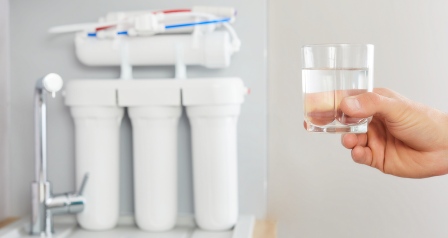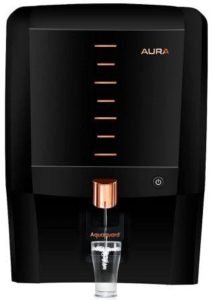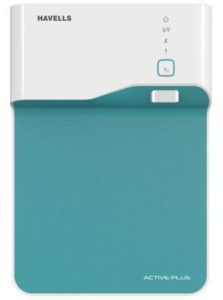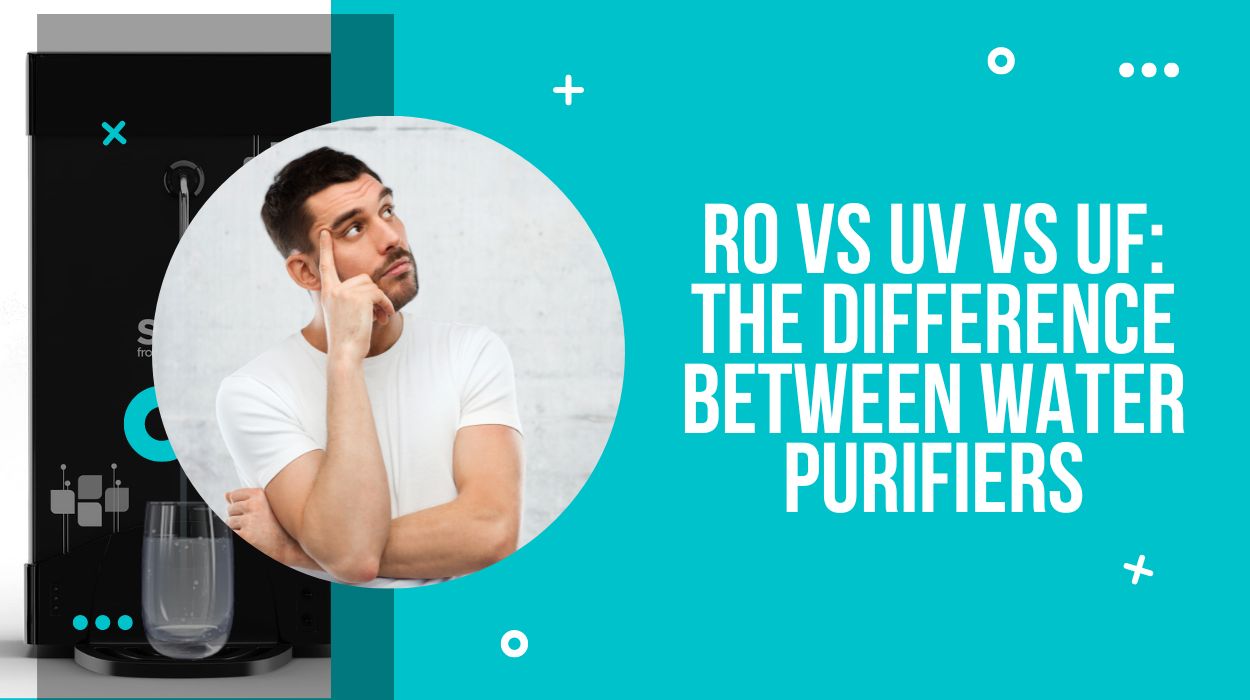Are you wondering if investing in the Best RO Water Purifier is worth the hype? Are you confused with the variety of purifiers available in the market? Are you thinking about purchasing a water purifier for home or office use or just curious about the technological advancement in water purification technology? You have reached the right article!
The three most popular purification technologies are reverse osmosis (RO), ultraviolet (UV), and ultrafiltration (UF). It is crucial to understand the three technologies’ basic principles to determine which is better. Well, we are here to rescue you!
In this article, we will discuss in detail all these methods! To make your choice more accessible, we have also created a cumulative comparative analysis between the three purifiers!
What Is An RO Water Purifier?

Reverse Osmosis is a process that involves the use of multiple membranes to eliminate contaminants from water. The membrane acts as a filter that removes particles depending on the filter membrane’s pore size. It can filter out particles like sand, minerals, dissolved solids, etc.
In this method, the property of reverse osmosis is used. The natural tendency of water is to move from a high solute concentration to a low solute concentration. In reverse osmosis, the movement is reversed; thus, additional pressure catalyzes the action from higher to low concentrations. Why is this needed? Because impure water will have high solute concentration than pure water!
RO purifiers have multiple stages depending on the number of membranes used while manufacturing the machine.
In the first step, the solid particles are allowed to settle in a tank. This tank is called the sedimentation tank.
The second stage has a Pre Carbon Filter; the carbon molecules present in this filter can trap ions and other contaminants.
The third stage has an RO Membrane. It is a semipermeable membrane that will only allow specific molecules to pass through it. Contaminants like heavy metals, toxic gases, dissolved solids, etc., cannot pass from this membrane.
The final stage is usually another carbon filter; however, it is called a post-carbon filter for ease of reference. This filter ensures that the water leaving the pipe is free from any odor and additional contaminants!
What Is A UV Water Purifier?

In this technique, germicidal Ultra Violet Rays are used to decontaminate and sterilize water. The wavelength of UV light that works best for disinfection is 245nm.
Microbes may become sterile and no longer multiply when exposed to UV rays, damaging their genetic material. Because alteration of the genetic code takes place, the organisms cannot replicate, making them non-infectious.
In this purifier, a UV lamp is present inside a quartz sleeve. When the bulb is on, the UV rays penetrate through glass and interact with the contaminants in the water.
What Is A UF Water Purifier?

In this method, ultra-filters with small pore sizes are used to entrap suspended solids, microorganisms, and other particulate matter present in water.
The most notable benefit of this purifying method is that it does not require energy or additional pressure to operate.
Difference Between RO, UV, And UV Water Purifiers
To understand which water purifier is better and which one you should invest in, one should compare them based on their features and abilities. Listed below is a comparison between the three technologies based on five characteristics.
1. Type Of Contamination Elimination

Water can be contaminated with a variety of toxins depending on the source. Physical contaminants include soil, mineral, salt, hazardous metals, and other substances that can alter the appearance of water. The type of the contaminant in a water sample contaminated with bacteria is biological. Chemical pollutants include substances such as bleach and insecticides.
An RO purifier has membranes that can effectively filter all three types of contaminants due to its membrane technology. The carbon filters can entrap toxic heavy metals like lead, mercury, cadmium, and other hazardous chemical compounds.
According to the guidelines suggested by Environmental Protection Agency (EPA), heavy metals like lead should not be present in drinking water because even minimal quantities of lead exposure can be fatal and result in cardiovascular and kidney diseases.
Thus, if the primary source of contamination is dissolved solids, you may want to invest in an RO Purifier.
A UV purifier will be an excellent investment if the predominant contaminant in the water is biological. UV radiation can cause DNA to mutate, allowing the disinfection of contaminated water. A UF purifier has filters that can eliminate solid particles and microbes; however, it cannot remove dissolved solids.
2. Electricity Requirement
One of the significant differences between RO purifiers and UF purifiers is that the former requires electricity to operate. Since UF purifiers work under the influence of gravity, if electricity is an issue, install a UF purifier.
UV and RO water purifiers are powered by electricity. However, an RO purifier can assist you in minimizing your electricity consumption. How? Well, RO purifiers are equipped with a storage tank; thus, you won’t have to use it as frequently as UV purifiers.
3. Water Wastage

One of the most significant disadvantages of an RO system is the wastewater produced throughout the process. Given that we live in an era when people are more concerned about their water usage, the liters of water wasted by RO filters would not sit well with many people.
UV and UF filters generate zero wastewater during the filtration process.
4. Maintenance

Like any other electronic machine, the water purifier must be cleaned and replaced at regular intervals. Since ROs have multiple filters, microorganism gets trapped in these filters. Microbes can multiply and form biofilms in the damp environment of the membranes. Thus, RO membranes need replacement every three years, which is an expensive process.
After a specific time, the UV bulb in UV filters may stop working or become less effective. As a result, they need replacing once a year to ensure that they continue sterilizing germs.
UF filters are more accessible to maintain; they have to be cleaned once a week to keep the filter from clogging.
5. Cost

Without a doubt, RO purifiers are an expensive investment; hence they cannot be considered an ideal purifier if you are on the hunt for a pocket-friendly one. The purifier’s carbon and sediment filters and RO membrane need to be replaced after a specific time; thus, it is a costly machine.
A UV purifier is comparatively less expensive with a low maintenance budget. A UF purifier is the best if you are looking for a quiet budget purifier with limited features.
The table below depicts the ability of the three purifiers against contaminants.
| Contaminant | RO Purifier | UV Purifier | UF Purifier |
| Heavy Metals | Yes | No | No |
| Monovalent Ions | Yes | No | No |
| Multivalent Ions | Yes | No | No |
| Viruses | Yes | Yes | Yes |
| Bacteria | Yes | Yes | Yes |
| Dissolved Solids | Yes | No | No |
| Suspended Solids | Yes | No | Yes |
FAQs
1. Is RO better than UV?
An RO purifier will be advantageous and a better solution if budget is not your concern. RO purifiers can filter microorganisms, and unlike UV purifiers, which leave dead organisms in the water, RO cleaned water is devoid of any organic waste.
2. Which method can purify water quickly?
The time required will be longer because more stages are involved in cleaning water with a RO filter. Additional pressure pumps are needed to purify water; consequently, purification will begin only when the required pressure is achieved.
UV and UF purifiers are great options if you’re looking for a purifier that will offer you pure water right away.
3. Do RO Water purifiers remove minerals from water?
Yes, well, an RO is a semipermeable membrane, and hence it filters out minerals and all the other impurities. However, some purifiers are equipped with mineral cartilage. These cartilages help in replenishing the purified water with essential minerals.
4. Can we combine them for a complete purification system?
Yes, a multi-technology purification system can provide you with the best of both technologies. Every technology has some drawbacks; combining them can give you a better result. For instance, when RO is coupled with a UF/UV filter, it can not only eliminate microorganisms but even kill them.
5. What are the drawbacks of a UV filter?
UV light can destroy 99.99% of microbes to accomplish thorough sterilization. However, a significant drawback of a UV filter is that it cannot alter the TDS of the water sample; hence it is ineffective in purifying hard water.
You May Also Like To Read:
Complete Buying Guide For Water Purifiers
The Difference Between Water Filter And Water Purifier
Which Water Purifier Is Best For Health?
Summary
Water with very high TDS can result in severe health consequences. If the level of solids is increased, an RO purifier is the best solution. If the number of microorganisms is the primary concern, a UV purifier will be a good choice. A UF filter can work without electricity; hence, it will not impact your electricity bill.
Let us know if you found this article helpful! Don’t forget to tell us which purifier did you invest in!


